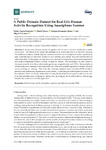Mostrar o rexistro simple do ítem
A Public Domain Dataset for Real-Life Human Activity Recognition Using Smartphone Sensors
| dc.contributor.author | García-González, Daniel | |
| dc.contributor.author | Rivero, Daniel | |
| dc.contributor.author | Fernández-Blanco, Enrique | |
| dc.contributor.author | Rodríguez Luaces, Miguel | |
| dc.date.accessioned | 2020-05-05T14:18:29Z | |
| dc.date.available | 2020-05-05T14:18:29Z | |
| dc.date.issued | 2020-04-13 | |
| dc.identifier.citation | Garcia-Gonzalez, D.; Rivero, D.; Fernandez-Blanco, E.; Luaces, M.R. A Public Domain Dataset for Real-Life Human Activity Recognition Using Smartphone Sensors. Sensors 2020, 20, 2200. https://doi.org/10.3390/s20082200 | es_ES |
| dc.identifier.issn | 1424-8220 | |
| dc.identifier.uri | http://hdl.handle.net/2183/25502 | |
| dc.description.abstract | [Abstract] In recent years, human activity recognition has become a hot topic inside the scientific community. The reason to be under the spotlight is its direct application in multiple domains, like healthcare or fitness. Additionally, the current worldwide use of smartphones makes it particularly easy to get this kind of data from people in a non-intrusive and cheaper way, without the need for other wearables. In this paper, we introduce our orientation-independent, placement-independent and subject-independent human activity recognition dataset. The information in this dataset is the measurements from the accelerometer, gyroscope, magnetometer, and GPS of the smartphone. Additionally, each measure is associated with one of the four possible registered activities: inactive, active, walking and driving. This work also proposes asupport vector machine (SVM) model to perform some preliminary experiments on the dataset. Considering that this dataset was taken from smartphones in their actual use, unlike other datasets, the development of a good model on such data is an open problem and a challenge for researchers. By doing so, we would be able to close the gap between the model and a real-life application. | es_ES |
| dc.description.sponsorship | This research was partially funded by Xunta de Galicia/FEDER-UE (ConectaPeme, GEMA: IN852A 2018/14), MINECO-AEI/FEDER-UE (Flatcity: TIN2016-77158-C4-3-R) and Xunta de Galicia/FEDER-UE (AXUDAS PARA A CONSOLIDACION E ESTRUTURACION DE UNIDADES DE INVESTIGACION COMPETITIVAS.GRC: ED431C 2017/58 and ED431C 2018/49) | es_ES |
| dc.description.sponsorship | Xunta de Galicia; IN852A 2018/14 | es_ES |
| dc.description.sponsorship | Xunta de Galicia; ED431C 2017/58 | es_ES |
| dc.description.sponsorship | Xunta de Galicia; ED431C 2018/49 | es_ES |
| dc.language.iso | eng | es_ES |
| dc.publisher | MDPI AG | es_ES |
| dc.relation | info:eu-repo/grantAgreement/AEI/Plan Estatal de Investigación Científica y Técnica y de Innovación 2013-2016/TIN2016-77158-C4-3-R/ES/VELOCITY: PROCESADO EFICIENTE DE BIG DATA ESPACIO-TEMPORAL PARA FLATCITY | |
| dc.relation.uri | https://doi.org/10.3390/s20082200 | es_ES |
| dc.rights | Atribución 4.0 Internacional | es_ES |
| dc.rights.uri | http://creativecommons.org/licenses/by/4.0/ | |
| dc.subject | HAR | es_ES |
| dc.subject | Human activity recognition | es_ES |
| dc.subject | Sensors | es_ES |
| dc.subject | Smartphones | es_ES |
| dc.subject | Dataset | es_ES |
| dc.subject | SVM | es_ES |
| dc.title | A Public Domain Dataset for Real-Life Human Activity Recognition Using Smartphone Sensors | es_ES |
| dc.type | info:eu-repo/semantics/article | es_ES |
| dc.rights.access | info:eu-repo/semantics/openAccess | es_ES |
| UDC.journalTitle | Sensors | es_ES |
| UDC.volume | 20 | es_ES |
| UDC.issue | 8 | es_ES |
| UDC.startPage | 2200 | es_ES |
| dc.identifier.doi | 10.3390/s20082200 |
Ficheiros no ítem
Este ítem aparece na(s) seguinte(s) colección(s)
-
GI-RNASA - Artigos [179]
-
GI-LBD - Artigos [35]







